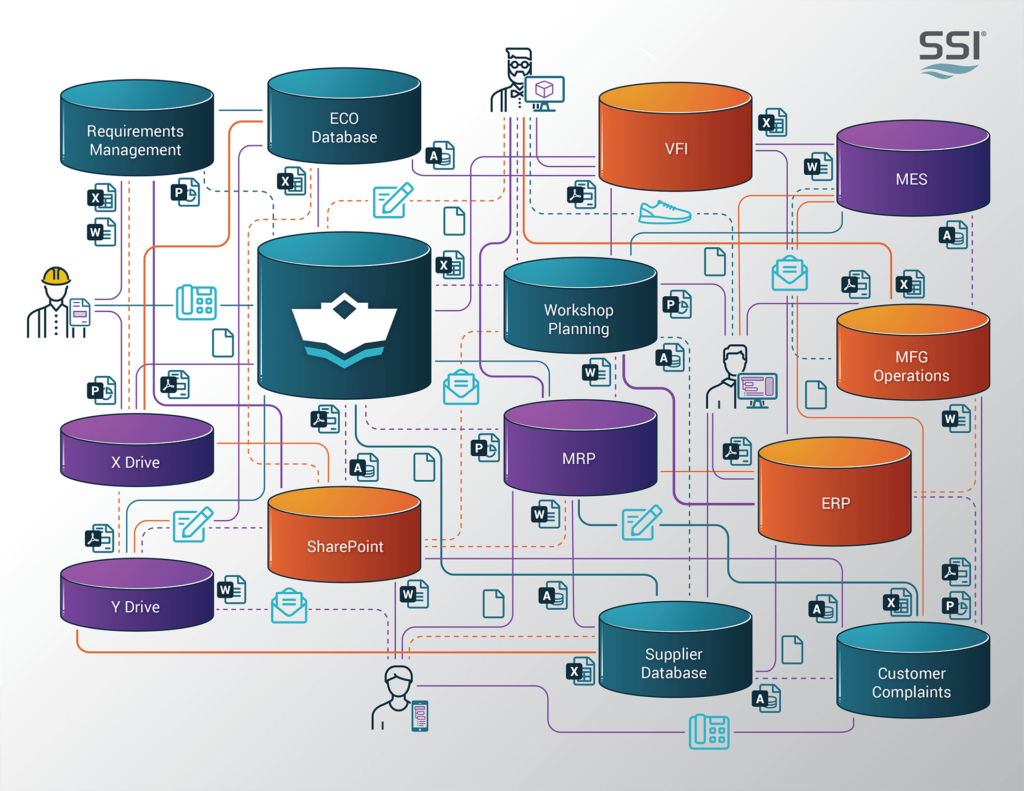How many digital transformations fail? Estimates range from around half to almost all. We’ve shared before how thinking holistically about your transformation and taking incremental steps can make it easy to get started. But once your shipyard is on the path, how do you identify and avoid common roadblocks – before they result in failure.
The 4 Roadblocks
Shipbuilders have found success with digital tools, there’s no doubt about that. 3D product models, digitized output, and digital enterprise resource planning (ERP) systems are commonplace. However, these individual pieces do not constitute a digital architecture, or digital-first organization. In reality, a significant amount of data is left out of that digital sphere, and the data that is captured cannot be trusted by every department all of the time.
In short, the roadblocks that appear can be grouped into four broad categories:
- Data fragmentation
- Poor information retrieval
- Inefficient change management
- Scalability issues
Let’s look at each one of these roadblocks individually, identify the symptoms that are clear indicators of a problem and outline a first step towards resolving them. When this exercise is done holistically across an organization, the odds of a successful digital transformation increase dramatically.
Data Fragmentation
Shipbuilding is too complex to realistically have all your data originate and stored in one place. There will always be some dispersal. However, the many organizations who build up their digital infrastructure without a view for how data will move across departments and tools. The result is consistent data fragmentation.

In general, the symptoms of fragmented data result in islands of data that are tenuously connected to each other. It may be difficult to move data from one source to another, or easier to recreate data rather than use an existing source.
That difficulty leaves departments uncertain about the state of the information they’re working with. If an individual team has created a view of the information that works for them, they could be left in a situation where the original source has changed, resulting in rework down the line when the discrepancy is discovered. At no stage do they have visibility into who is editing what and when.
Poor Information Retrieval
Even if data systems are not fragmented, information retrieval challenges can remain. Apart from the previously mentioned uncertainty around the recency of data, teams add risk to their processes by retrieving information directly from a live system and add unnecessary manual work by consistently generating the same reports.
Inefficient Change Management
A common digital transformation roadblock, that is especially relevant to shipbuilders, is inefficient change management. As projects become increasingly complex, this challenge becomes an even more important aspect of the business to get right.
Some common symptoms are changes that affect multiple subsystems, changes and work not being reused across hulls and projects, and not being able to trace individual change activities down to the part level.
The underlying issue behind these inefficiencies is a missing ability to compare and configuration control the project through time and across the entire lifecycle. Without that, even with digital tools in place, your shipyard won’t see the expected benefits to series projects that the initial transformation set out to achieve.
Scalability Issues
A key part of a successful digital transformation is approaching the problem incrementally, rather than hoping for an all or nothing success story. However, when those incremental steps are not done in the context of a complete transformation for the entire organization, it can lead to scalability issues.
These issues are fairly straightforward to identify. A process or system that works for small designs, or subsets of a project, does not scale up for complex projects, becomes difficult for the entire organization to access information that was easily accessible to the pilot group, or a big gap between phases of a system’s implementation are all symptoms of a scalability issue.
Overcoming the Roadblocks
A centralized platform for product data and relationships is emerging as the way forward to these challenges. Broadly, such a system can be categorized as an integrated shipbuilding PLM platform; however, as we now know, it’s more valuable to define what we want to achieve instead of what tool we want to use.
See what that means for your shipyard, and how you can tackle these roadblocks within your organization by reading our whitepaper:

Whitepaper: Transformation Roadblocks
For shipbuilders to see transformation success, they need to overcome the pitfalls of traditional technology implementations.
Read the whitepaper to see how your teams can overcome the 4 roadblocks to digital transformation success.
Read Whitepaper